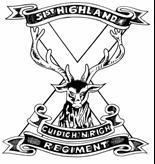 | ||
The Highland Brigade is a historical unit of the British Army, which has been formed and reformed a number of times. It recruited men from the Highlands of Scotland.
Contents
Crimean War
A Highland Brigade was present at the Crimean War (1854–1856), as part of the 1st Division; it was initially under the command of Major-General Sir Colin Campbell (Lord Clyde). It played a significant role in the Battle of Alma.
This Highland Brigade consisted of the:
Egyptian Rebellion
There was a Highland Brigade operating in Egypt from 1882, during the Egyptian Rebellion (1882–1885), under the command of Major General Archibald Alison. Major General Alison's Brigade formed the left wing of General Sir Garnet Wolseley's army at the Battle of Tel-El-Kebir where they suffered 243 casualties (from the total casualties for Wolsey's force of 339).
This Highland brigade consisted of the:
Second Boer War
A Highland Brigade participated in the Second Boer War (1899–1902) in South Africa, under the command of Major General Andrew Gilbert Wauchope. It suffered severe losses at the battle Magersfontein (including General Wauchope). Command of the Brigade was then given to Major General Hector MacDonald who led the brigade throughout the remainder of the war. The Brigade fought at the Battle of Paardeberg where on 18 September (known as Bloody Sunday) it again suffered heavy casualties.
The Highland Brigade consisted of the:
Administrative Brigade 1948–1968
After the Second World War the British Army had fourteen infantry depots, each bearing a letter. The depots were territorially organised, and Infantry Depot N was the headquarters for the highland regiments.
In 1948, the depots adopted names and this depot became the Highland Brigade, with all regiments being reduced to a single battalion at the same time. The Highland Brigade was formally created on 14 July 1948 from the depots of six regiments:
Under the Defence Review announced in July 1957, the infantry of the line was reorganised, and by 1961 the Brigade was reduced to four battalions:
From 1958 all regiments in the Brigade adopted a common cap badge consisting of the saltire of St. Andrew on which was superimposed a stag's head and a scroll inscribed Cuidigh 'n Righ. The various Territorial Battalions that were also part of the then five Highland Regiments were split off in 1967 and grouped together, eventually forming the 51st Highland Volunteers.
On 1 July 1968 the Highland Brigade was united with the Lowland Brigade, to form the Scottish Division.
